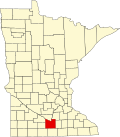There are 87 counties in the U.S. state of Minnesota. There are also several historical counties.
Contents
On October 27, 1849, nine counties were established: Benton, Dahkotah, Itasca, Ramsey, Mahkahta, Pembina, Wabasha, Washington, and Wahnata. Six of these names still exist. With the foundation of Kittson County on March 9, 1878, Pembina County no longer existed. [1] When Minnesota was organized as a state, 57 of the present 87 counties were established. The last county to be created was Lake of the Woods County in 1923. [2]
The names of many of the counties allude to the long history of exploration. Over ten counties are named for Native American groups residing in parts of what is now Minnesota. Another fifteen counties are named after physical geographic features, and the remainder for politicians.
The FIPS county code is the five-digit Federal Information Processing Standard (FIPS) code which uniquely identifies counties and county equivalents in the United States. The three-digit number is unique to each individual county within a state, but to be unique within the entire United States, it must be prefixed by the state code. This means that, for example, the number 001 is shared by Aitkin County, Minnesota, Adams County, Wisconsin, and Adair County, Iowa. To uniquely identify Aitkin County, Minnesota, one must use the state code of 27 plus the county code of 001; therefore, the unique nationwide identifier for Aitkin County, Minnesota is 27001. The links in the column FIPS County Code are to the Census Bureau Info page for that county. [3]























































































